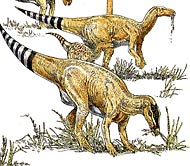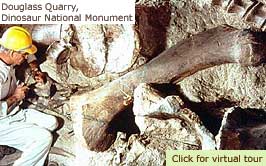| Earl Douglass of the Carnegie Museum in Pittsburgh, PA, discovered the fossils in 1909 that gave the park its name. He knew that some of the rocks in northeastern Utah were the same kind that had produced dinosaur skeletons elsewhere. The scientist went to Utah to look for more bones for the museum and found thousands. Douglass spent many years digging the bones up and shipping them to the Carnegie Museum where many skeletons are now on display. Today, Dinosaur National Monument only allows authorized excavations by qualified paleontologists under permit.
President Woodrow Wilson proclaimed the great dinosaur quarry as Dinosaur National Monument in 1915. The rock layer containing the fossil bones forms a massive wall of the Quarry Visitor Center where more than 1,400 bones can be seen. The Quarry face is divided into sections. Each bone has a catalog number and is keyed to a grid system that allows visitors to locate the fossils.
|
There is an unusually large concentration of bones in one place, as this area was once a watering hole. The rock around the fossil bones tells us that an ancient river once flowed there. Scientists believe that at one time, about 150 million years ago, the river dried up during a drought. The last watering hole was located where the Quarry Visitor Center is today. As the watering hole vanished, the dinosaurs died. Their carcasses were scattered about the dried riverbed. After the drought ended, the river again began to flow. Over time, dinosaur bones were buried under sand and gravel, and the fossilization process began.
As ages passed, that river vanished. Other rivers and seas came and went, leaving layer after layer of sand and mud that slowly solidified into rock. As water seeping through the ground filled the buried bones with dissolved silica, they became rock hard.
About 65 million years ago, strong vise-like forces began squeezing the Earth's crust, bending and tilting the rock layer in this area. Think of how the pages of a paperback book bend if you push on it from opposite sides. The more the rocks were pushed upward, the more they were worn down by rain, snow, frost, and wind. layer by layer.
Eventually, some of the long-buried dinosaur bones began to show up near the top of a steep hill where Earl Douglass found them.
|




















